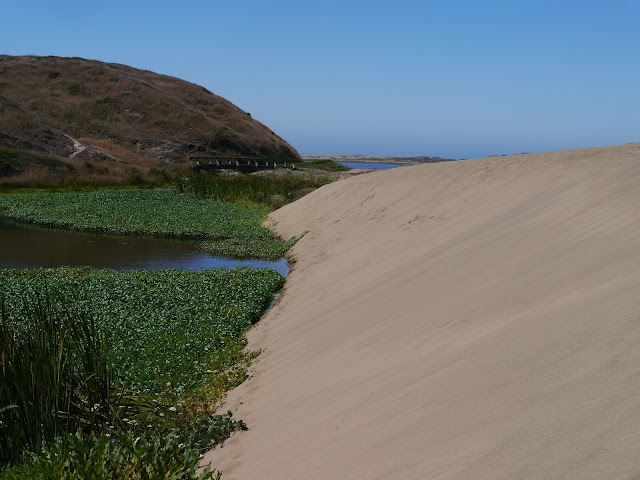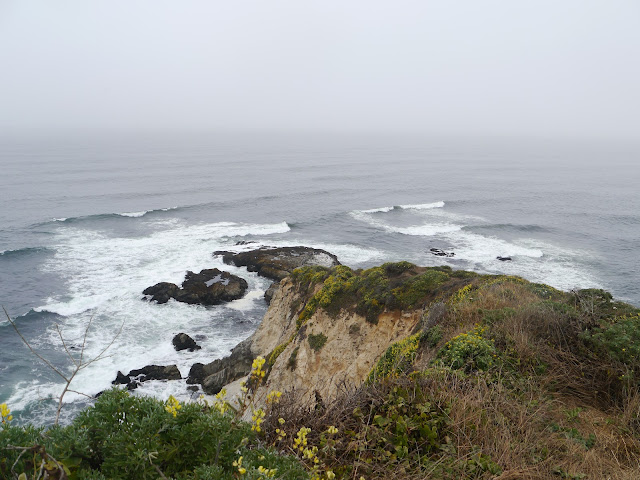"The Douglas fir trees were called chime chwing in the Hupa
language. Nothing was eaten from them. They were not used to build houses.
Their economic value was negligible: deadwood on the ground was collected for
firewood, walking canes were made from their limbs. Other less abundant plants
had considerably more material value: the essential oak tree, prairies of
Indian potato tubers and seed-bearing grasses, rare medicinal plants, sugar
pine, and red cedar. However, the Douglas fir, growing tall in the High Country, was a passageway to the other worlds in the sacred landscape, a
passageway to the Immortals. […] The tops of tall trees on high mountains were
at the Top Of This Earth, and the places closest to and most easily seen by the
Immortals from the Sky Above.
Places of
Passage were associated with Times of Passage— into life at birth and out of
life at death. The Times of Passage into and out of life on This Earth were marked
with ritual activity involving high places and trees. (…)
 |
| Enormous fallen Douglas fir right over the path on the way to Alamere Falls |
Birth
The father of a newborn baby took
the stump of its umbilical cord, which fell off a few days after birth, into
the hills of a high, windswept point with a sweeping view. He found a sapling
of a Douglas fir tree and split its most upward pointing branch, placed the
umbilicus inside the split and tied the branch back around the baby’s navel
stump. As the baby tree grew up, so the child’s physical and spiritual growth
was measured. This tree was watched by the baby’s family and later by the
maturing individual. As the sapling Douglas fir grew in shape and strength, it
became Nature’s medicine counterpart, the spiritual omen for this individual.
At the ridge where the baby’s
medicine tree grew, or on the father’s journey to it, it was propitious if the
father found a medicine plant. From the plant he either took a part home or
took the plant itself to transplant near the village as the baby’s medicine
plant. These birthcounterparts, trees, plants, special rocks, and so on, were
talismans of luck and power. They were one’s lifelong personal medicine, and
were called xwen natehidichwen,
meaning “along with this person, medicine was born.
Death
At the death of a man, his
sweathouse partners took the pipe which he had smoked for religious
communication and placed it at the top of a Douglas fir, high upslope. Some
other item of ceremonial regalia personally associated with him could be placed
at the tree top as well. His body was buried in the ground, but his pipe and
regalia were placed high and clear where the Immortals could see them. The
Immortals spent all their time dancing ceremonies and if they admired and
desired his religious regalia, they might bring him with his dancing wealth to
Sky Above."
I think this is so beautiful-- the cord woven between human being and Douglas fir tree from birth to death in Hupa culture. A tree that has your umbilical cord buried within it, well, that is something very strong indeed, a place where you, very literally, have roots.
I think this is so beautiful-- the cord woven between human being and Douglas fir tree from birth to death in Hupa culture. A tree that has your umbilical cord buried within it, well, that is something very strong indeed, a place where you, very literally, have roots.
This fallen Douglas fir was so big I could have laid out a blanket and slept on its bark. We could walk beneath, packs and all, almost without ducking.
We walked up through the branches, horizontally of course, but it was still like climbing a ladder. The very top was narrow and dense, grown with moss and lichens touched by wind and osprey, robins and sun. To imagine the whole tree upright-- it does feel like they might pierce straight into another world. It felt like we had walked into a new wild territory, at the top of that fallen tree, a place humans rarely go.
A while ago, I wrote a sketch about Douglas fir trees, how they need fire to open their pinecones and birth their seeds. It became something magic and strange. It is connected to the piece I mentioned in my last post, the mythic story-beginning with Edith and the old women who have bones in their hair, right here.
These are scraps of a Point Reyes myth world rapidly evolving in my head, soon to become something longer, I hope! Enjoy:
A while ago, I wrote a sketch about Douglas fir trees, how they need fire to open their pinecones and birth their seeds. It became something magic and strange. It is connected to the piece I mentioned in my last post, the mythic story-beginning with Edith and the old women who have bones in their hair, right here.
These are scraps of a Point Reyes myth world rapidly evolving in my head, soon to become something longer, I hope! Enjoy:
The Douglas-fir tree drops
whiskered cones between the bracken ferns and the leaves of wild ginger. Old
tapers of pale lichen hang from the straight branches. The breeze moves them,
slowly. Old Man’s Beard, the lichen is called, brittle and green. Sometimes
Douglas-firs are draped everywhere, on all of their swaying branches, with
lichen, each dip of green smelling of humus and songbirds.
The whiskered cones need fire to break open the seeds
they protect. A rough blaze to crackle off the husk, to flush the soil fresh
with ash for the new roots. The ashes of the dead to feed them. Branches and
ferns and huckleberries up in orange flames. Fire that roars, whistles, and
transmutes the bodies of crickets, yellow-sapped saplings, Northern spotted
owls, into dirt. Mountain beavers, burrowers with tunnels under the roots, in
places where rain water seeps, are roasted. Between their white bones the
Douglas-fir seeds, skins melted open, reach their tiny clear veins. Seedlings grow
to saplings. When their roots are as thick as earth worms, they crush the small
skulls of the mountain beavers.
The fire Edith sees glowing the Inverness ridge one
morning was lit by the young men with fire in their eyes, the men who smoke
long thin pipes and sing like birds. When fallen branches gather up enough,
they go out to the fir forests and drop the embers of their tobacco in the dry
twigs and grasses. They watch as the underbrush catches, as flames move against
the trunks of grown Douglas-firs, barely singeing. They sing and their tongues
make sounds like the fire cracking. A fire for rebirth. The oldest great blue
herons, with thin, ragged feathers and long beaks worn from hunting, emerge
from the salt marshes and estuaries as the first grey pine smoke rises. They
fly to the edge of the burning, where the young men sit, smoking and singing
and holding fire in their palms. With slow steps, they walk into the lapping
heat.
An old woman with gopher bones in her hair crawls out of
the warrens and woodrat lodges once the ground has cooled. She is called
Heron-claw. She reaches her dark feathered hands into the phoenix ashes of the
herons and pulls out the new eggs. Reborn from the dust of their deaths, like
Douglas fir seeds reborn only in heat. Dark blue eggs with stars on the shells
drawn by embers. She tucks them into deep square pockets. Gathers fire-opened
Douglas-fir seeds, popped out of their cones, and chews them between
green-stained teeth. Quietly, she slips back down the warrens, ginger-stepping,
with eggs in her pockets.
 |
| Great blue heron |
 |
| Blue heron |
















































